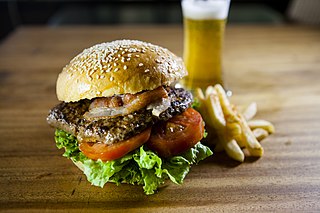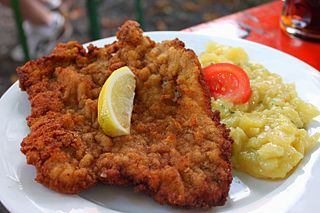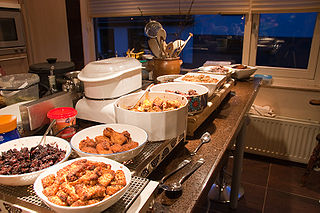
A hamburger, or simply a burger, is a dish consisting of fillings—usually a patty of ground meat, typically beef—placed inside a sliced bun or bread roll. The patties are often served with cheese, lettuce, tomato, onion, pickles, bacon, or chilis with condiments such as ketchup, mustard, mayonnaise, relish or a "special sauce", often a variation of Thousand Island dressing, and are frequently placed on sesame seed buns. A hamburger patty topped with cheese is called a cheeseburger. Under some definitions, and in some cultures, a burger is considered a sandwich.

A veggie burger or meatless burger is a hamburger made with a patty that does not contain meat, or the patty of such a hamburger. The patty may be made from ingredients like beans, nuts, grains, seeds, or fungi such as mushrooms or mycoprotein.

Steak tartare or tartar steak is a French dish of raw ground (minced) beef. It is usually served with onions, capers, parsley or chive, salt, pepper, Worcestershire sauce, and other seasonings, often presented separately, to be added to taste. It is commonly served topped with a raw egg yolk. It is similar to the Levantine kibbeh nayyeh, the Turkish çiğ köfte and the Korean yukhoe.

Schnitzel is a thin slice of meat. The meat is usually thinned by pounding with a meat tenderizer. Most commonly, the meat is breaded before frying. Breaded schnitzel is popular in many countries and is made using veal, pork, chicken, mutton, beef, or turkey. Schnitzel originated as wiener schnitzel and is very similar to other breaded meat dishes.

Korokke is a Japanese deep-fried yōshoku dish originally related to a French dish, the croquette. Korokke is made by mixing cooked chopped meat, seafood, or vegetables with mashed potato or white sauce, usually shaped like a flat patty, rolling it in wheat flour, eggs, and Japanese-style breadcrumbs, then deep-frying this until brown on the outside.

Salisbury steak is a dish originating in the United States and made from a blend of ground beef and other ingredients, being considered a version of Hamburg steak. Today, Salisbury steak is usually served with a gravy similar in texture to brown sauce, along with various side dishes, such as mashed potatoes and cooked vegetables. It is a common menu item served by diners and is frequently available as a TV dinner in supermarket frozen food sections.

A rissole is "a ball or flattened cake of chopped meat, fish, or vegetables mixed with herbs or spices, then coated in breadcrumbs and fried."

A slinger is an American Midwest diner specialty typically consisting of two eggs, hash browns, and a ground beef patty, all covered in chili con carne and generously topped with cheese and onions. The eggs can be any style. Hot sauce is usually served on the side. The slinger is considered to be a St. Louis late-night culinary original. It is described as "a hometown culinary invention" of a mishmash of meat, hash-fried potatoes, eggs, and chili, sided with a choice of ham, sausage, bacon, hamburger patties, or an entire T-bone steak.

Pljeskavica is a Serbian grilled dish consisting of a mixture of spiced minced pork, beef and lamb meat. It is one of the national dishes of Serbia and is very popular in the neighbouring Balkan and former Yugoslav countries of Bosnia and Herzegovina, Croatia, and Montenegro. The dish is also popular in Bulgaria and Romania. It is a main course served with onions, kajmak, beans, sometimes ajvar (relish), and urnebes, either on plate with side dishes, or with lepinja. Recently, pljeskavica has gained popularity elsewhere in Europe and is served in a few speciality fast food restaurants in Germany, Sweden, and Austria. Varieties include the "Leskovac pljeskavica", very spicy with onions; "Šar pljeskavica", stuffed with kačkavalj cheese; "Hajduk pljeskavica", of beef mixed with smoked pork meat; and "Vranje pljeskavica".

Hamburg steak is a patty of ground beef. Made popular worldwide by migrating Germans, it became a mainstream dish around the start of the 19th century. It is related to Salisbury steaks, which also use ground beef. It is considered the origin of the hamburger, when, in the early 20th century, vendors began selling the Hamburg steak as a sandwich between bread.
McDonald's Corporation is the world's largest chain of fast food restaurants, serving around 68 million customers daily in 119 countries. McDonald's traces its origins to a 1940 restaurant in San Bernardino, California, United States. After expanding within the United States, McDonald's became an international corporation in 1967, when it opened a location in Richmond, British Columbia, Canada. By the end of the 1970s, McDonald's restaurants existed in five of the Earth's seven continents; an African location came in 1992 in Casablanca, Morocco.

A croquette is a deep-fried roll originating in the Mediterranean basin, consisting of a thick binder combined with a filling, which is then breaded. It is served as a side dish, a snack, or fast food worldwide.

A steak is a thick cut of meat generally sliced across the muscle fibers, sometimes including a bone. It is normally grilled or fried. Steak can be diced, cooked in sauce, such as in steak and kidney pie, or minced and formed into patties, such as hamburgers.

Breaded cutlet or braised cutlet is a dish made from coating a cutlet of meat with breading or batter and either frying or baking it.

Indo cuisine is a fusion cooking and cuisine tradition, mainly existing in Indonesia and the Netherlands, as well as Belgium, South Africa and Suriname. This cuisine characterized of fusion cuisine that consists of original Indonesian cuisine with Eurasian-influences—mainly Dutch, also Portuguese, Spanish, French and British—and vice versa. Nowaday, not only Indo people consume Indo cuisine, but also Indonesians and Dutch people.























